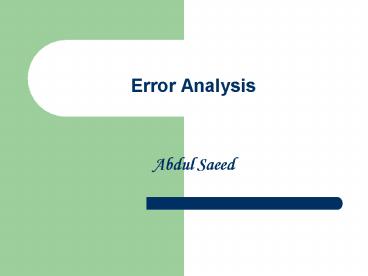Error Analysis Abdul Saeed - PowerPoint PPT Presentation
1 / 18
Title:
Error Analysis Abdul Saeed
Description:
Error Analysis Abdul Saeed Definitions Error Corder (1967) states error as a breach of code. Norrish (1983) defines error as a systematic deviation when a learner ... – PowerPoint PPT presentation
Number of Views:298
Avg rating:3.0/5.0
Title: Error Analysis Abdul Saeed
1
Error AnalysisAbdul Saeed
2
Definitions
3
Error
- Corder (1967) states error as a breach of code.
- Norrish (1983) defines error as a systematic
deviation when a learner has not learnt something
and consistently gets it wrong.
4
Mistake
- , A mistake refers to a performance error that
is either a random guess or a slip in that it
is a failure to utilize a known system
correctly.
5
Behaviourists view
- people learn language by responding an external
stimuli and receiving proper reinforcement. Thus,
a proper habit is formed and language learning
takes place. Therefore, errors were deemed as a
sign of failure on the part of the learners as
well as teachers.
6
Mentalists view
- The conviction is that error is inevitable. It
is an integral part of the learning process and
developing competence. It should not be regarded
as a sign of failure but as evidence that the
student is working his way towards the correct
rules.
7
Competence Performance
- Competence is the abstract knowledge of language
in the mind - Performance is the realisation of the knowledge
in concrete form.
8
Error Analysis
- Ellis (1985) stated in favour of EA claiming that
these are the errors that let us know that how
the language process is going on, what the stage
of the learner is , what kind of difficulties are
being faced and consequently how these problems
can be solved.
9
Types of Errors
- Interlingual and Intralingual Errors
- Interlingual errors are said to occur due to the
interference of L1 into L2. In this case previous
learned structures create problems for the
learner to learn new language. - Intralingual errors are those errors that occur
due to the faulty or partial learning of the TL
such as overgeneralization and oversimplification.
10
Overt and Covert Errors
- An error can be overt (the deviation is apparent
in the surface form of the utterance) or covert
errors (the deviation is only deviant when the
learners meaning intention is taken into
account) - For example, ? I happy instead of I am
happy. ? Indicates error - I am fine, thank you.
11
Causes and Sources of Errors
- 1 Overgeneralisation
- Learners of second language sometimes apply
previous learned rules on the target language
without appropriate knowledge of their
application. Thus, they commit error.
12
2.Ignorance of Rule Restriction
- In every language every lexical item has some
rules and restrictions to be used with adjacent
lexical items. For example, the pronoun who has
the restriction that it should be used with
living creatures not with non-living things.
13
3. L1 Transfer
- According to Behaviourist learning theory, old
habits get in the way of learning new habits.
Thus, in L2 acquisition the patterns of the
learners mother tongue that are different from
those of the L2 get in the way of the learning L2
14
(No Transcript)
15
- Error Treatment
16
Negative Aspect
- Truscott opines that grammar correction has no
place in writing courses and should be abandoned
because it is not only ineffective but also
harmful for the learners. - (1) grammar correction can not work until or
unless the learner himself is not interested to
practice them and make them the part of his
cognition.
17
- (2) correction may be a source to demotivate the
learner. Round circles, underlined words,
different clues in red ink and long comments may
leave very serious effects on the learner
consequently ending in giving up the learning
process
18
Positive Aspect
- Hammerly (1991) states that adult language
learners make hypotheses about the target
language. These hypotheses may be right or wrong.
So, according to Hammerly (1991) feedback is
necessary for these learners to test the
authenticity of their hypotheses. - Nunan and Lamb (1996) also speak in favour of
error correction as it can provide the learners
with valuable information in the target language
(p, 68).































